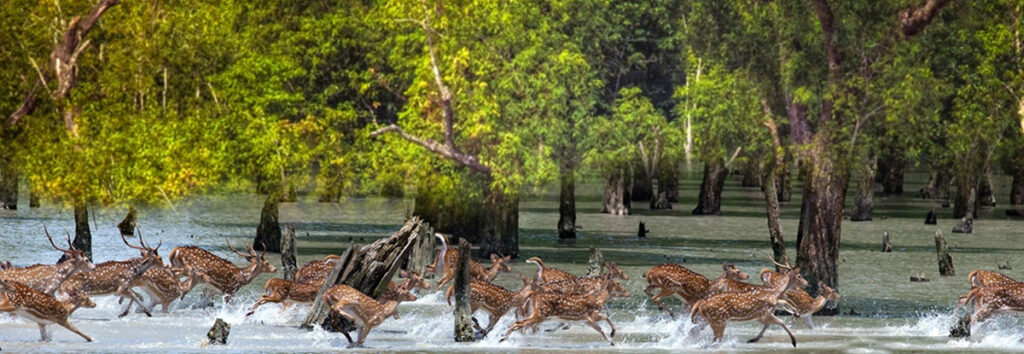When people think of the Sundarbans, the first thing that comes to mind is the majestic Royal Bengal Tiger. However, this UNESCO World Heritage Site is so much more than just a tiger reserve. It is a sprawling, dynamic ecosystem teeming with life, a place where land and water merge in a labyrinth of mangroves, creating a unique environment that supports a diverse range of flora and fauna. The Sundarbans, one of the largest river deltas in the world, offers a wildlife adventure that goes far beyond its famous big cats.
In this article, we will take you on a journey through the Sundarbans, exploring its incredible biodiversity, the cultural heritage of the region, and the many experiences that await travelers who are willing to look beyond the tigers.
1. The Mystique of the Sundarbans

The Sundarbans is a massive mangrove forest that stretches across the southern part of Bangladesh and the eastern part of India, covering an area of approximately 10,000 square kilometers. The name “Sundarbans” is derived from the Sundari trees, which are abundant in the region. The forest is crisscrossed by a complex network of rivers, creeks, and estuaries, making it a unique and challenging terrain to explore.
The Sundarbans is not just a wildlife sanctuary; it is a place where nature reigns supreme. The interplay between land and water creates a constantly changing landscape where the tides dictate the rhythm of life. This dynamic environment is home to an incredible variety of species, many of which are endemic to the region.
2. The Diverse Ecosystem
The Sundarbans’ ecosystem is incredibly diverse, with a wide range of habitats that support a variety of species. From dense mangrove forests to mudflats, saltwater marshes, and freshwater swamps, the Sundarbans is a living laboratory of biodiversity.
2.1. Mangrove Forests
Mangroves are the lifeblood of the Sundarbans, providing a crucial habitat for many species. The tangled roots of the mangrove trees create a natural barrier against coastal erosion and provide shelter for a variety of marine life. The Sundarbans is home to the largest mangrove forest in the world, and it is this unique environment that makes the region so special.
2.2. Flora
While the Sundari tree is the most famous plant species in the Sundarbans, the forest is home to over 50 species of mangroves and hundreds of other plant species. The flora of the Sundarbans has adapted to the saline environment, with many species developing specialized roots to survive in the brackish waters.
2.3. Fauna
The Sundarbans is home to an impressive array of wildlife, including over 400 species of vertebrates. In addition to the Royal Bengal Tiger, the Sundarbans is home to:
- Saltwater Crocodiles: The Sundarbans is one of the few places in the world where saltwater crocodiles can be found in their natural habitat. These ancient reptiles are apex predators and are often spotted basking on the riverbanks.
- Irrawaddy Dolphins: These rare and endangered dolphins are often seen in the waters of the Sundarbans. They are known for their rounded foreheads and are a unique sight for wildlife enthusiasts.
- Fishing Cats: These elusive and nocturnal creatures are well-adapted to the watery environment of the Sundarbans. They are excellent swimmers and are often seen hunting fish in shallow waters.
- Spotted Deer: The Sundarbans is home to large herds of spotted deer, which are often seen grazing on the forest floor. They are a primary prey species for the tigers and are a common sight in the region.
- Birdlife: The Sundarbans is a birdwatcher’s paradise, with over 300 species of birds recorded in the region. From the majestic white-bellied sea eagle to the vibrant kingfishers and the migratory birds that visit during the winter months, the Sundarbans is a haven for avian life.
2.4. The Marine Life
The waters of the Sundarbans are teeming with marine life, from tiny crabs and prawns to large fish and even sharks. The region is also known for its rich oyster and clam beds, which are an important source of livelihood for the local communities.
3. The Royal Bengal Tiger – The Star of the Show

The Royal Bengal Tiger is undoubtedly the most iconic species of the Sundarbans. These elusive big cats are the largest tiger subspecies and are known for their distinctive orange coats with black stripes. The Sundarbans is home to an estimated 96 to 100 tigers, making it one of the most important tiger reserves in the world.
3.1. The Elusive Nature of the Tigers
Spotting a tiger in the Sundarbans is no easy task. The dense mangroves and the elusive nature of the tigers make them difficult to track. However, the thrill of searching for these magnificent creatures is part of the adventure. The Sundarbans’ tigers are known to be excellent swimmers, often crossing rivers and creeks in search of prey. They are also more aggressive than tigers in other regions, possibly due to the challenging environment they inhabit.
3.2. Conservation Efforts
The Royal Bengal Tiger is listed as endangered, and conservation efforts in the Sundarbans are focused on protecting this iconic species. The Sundarbans Tiger Reserve in India and the Sundarbans Reserve Forest in Bangladesh are dedicated to conserving the tiger population and its habitat. Anti-poaching measures, community engagement, and habitat restoration are key components of these conservation efforts.
4. Beyond the Tigers – Other Wildlife Wonders
While the tigers are the stars of the Sundarbans, there is so much more to see and experience in this unique wilderness. Here are some of the other wildlife wonders that make the Sundarbans a must-visit destination:
4.1. The Saltwater Crocodile

The saltwater crocodile, also known as the estuarine crocodile, is one of the largest reptiles in the world. These formidable creatures can grow up to 7 meters in length and are known for their powerful jaws and stealthy hunting techniques. The Sundarbans is one of the few places where you can see saltwater crocodiles in their natural habitat. These apex predators are often spotted basking on the riverbanks or lurking in the shallow waters, waiting for their next meal.
4.2. The Irrawaddy Dolphin

The Irrawaddy dolphin is a rare and endangered species that is often seen in the waters of the Sundarbans. These dolphins are known for their rounded foreheads and short beaks, which give them a distinctive appearance. Unlike other dolphin species, Irrawaddy dolphins are not particularly acrobatic, but their unique behavior and appearance make them a fascinating sight for wildlife enthusiasts.
4.3. The Fishing Cat

The fishing cat is a nocturnal predator that is well-adapted to the watery environment of the Sundarbans. As the name suggests, these cats are excellent swimmers and are known for their ability to catch fish. Fishing cats are elusive and difficult to spot, but their presence adds to the mystique of the Sundarbans. They are often found near water bodies, where they hunt for fish, crabs, and other small aquatic creatures.
4.4. The Spotted Deer

The spotted deer, also known as the chital, is one of the most common and easily spotted animals in the Sundarbans. These graceful creatures are often seen grazing in the clearings of the forest, and their presence is a vital part of the ecosystem. Spotted deer are a primary prey species for the tigers, and their large herds can be seen throughout the Sundarbans.
4.5. The Avian Paradise

The Sundarbans is a birdwatcher’s paradise, with over 300 species of birds recorded in the region. The diverse habitats of the Sundarbans, from mangrove forests to mudflats and open water, provide a haven for a wide variety of avian species. Some of the notable bird species that can be spotted in the Sundarbans include:
- The White-Bellied Sea Eagle: This majestic bird of prey is often seen soaring over the waters of the Sundarbans, hunting for fish and other marine creatures.
- The Kingfishers: The vibrant kingfishers are a common sight in the Sundarbans, with their bright plumage and sharp beaks. They can often be seen diving into the water to catch fish.
- The Lesser Adjutant Stork: This large and rare stork species is a fascinating sight in the Sundarbans, with its distinctive appearance and slow, deliberate movements.
- The Migratory Birds: During the winter months, the Sundarbans becomes a haven for migratory birds, including sandpipers, plovers, and other shorebirds. These birds travel thousands of kilometers to escape the harsh winters of the north and find refuge in the warm and abundant wetlands of the Sundarbans.
5. Cultural Heritage and Local Communities
The Sundarbans is not just a wilderness; it is also home to a vibrant and resilient community of people who have lived in harmony with the forest for generations. The local communities of the Sundarbans, known as the “Mouals,” depend on the forest for their livelihoods, engaging in activities such as fishing, honey collection, and traditional agriculture.
5.1. The Honey Collectors – The Mouals

One of the most unique aspects of life in the Sundarbans is the tradition of collecting honey. The honey collectors, known as “Mouals,” venture deep into the mangrove forests during the honey season to collect honey from wild bee hives. This is a dangerous task, as they often encounter tigers and other wildlife during their expeditions. The honey collected in the Sundarbans is known for its distinctive flavor, which comes from the nectar of the mangrove flowers.
5.2. The Fishermen

Fishing is another important livelihood for the people of the Sundarbans. The waters of the Sundarbans are rich in fish, crabs, and prawns, which are a vital source of food and income for the local communities. Traditional fishing methods, such as using nets and traps, are still widely practiced in the region.
5.3. The Role of Women in the Sundarbans

Women play a crucial role in the local economy of the Sundarbans. In addition to their responsibilities in the home, many women are involved in activities such as weaving, handicraft production, and small-scale farming. Women’s self-help groups are also becoming increasingly common in the Sundarbans, empowering women to take charge of their economic future.
5.4. The Cultural Traditions

The Sundarbans is rich in cultural traditions, many of which are influenced by the natural environment. Festivals, rituals, and folklore often revolve around the forest and its inhabitants. One of the most significant cultural events in the Sundarbans is the Bonbibi Puja, a festival dedicated to Bonbibi, the guardian deity of the forest. Bonbibi is revered by both Hindus and Muslims in the Sundarbans, and her blessings are sought for protection from tigers and other dangers of the forest.
6. Exploring the Sundarbans – A Traveler’s Guide
Visiting the Sundarbans is a unique and unforgettable experience. However, due to the challenging terrain and the delicate nature of the ecosystem, it is essential to plan your trip carefully. Here is a guide to help you make the most of your visit to the Sundarbans.
6.1. When to Visit?
The best time to visit the Sundarbans is during the winter months, from November to February. The weather is cooler and more pleasant during this time, making it ideal for exploring the forest. The monsoon season, from June to September, should be avoided, as heavy rains can make travel difficult and dangerous.
6.2. How to Reach the Sundarbans?

The Sundarbans is accessible from both India and Bangladesh. If you are visiting from India, the nearest major city is Kolkata. From Kolkata, you can take a train or bus to Canning, which is the gateway to the Indian Sundarbans. From Canning, you can hire a boat to take you into the heart of the Sundarbans.
If you are visiting from Bangladesh, the nearest major city is Khulna. From Khulna, you can take a boat ride to the Sundarbans, which takes around 5 to 6 hours.
6.3. Where to Stay?
Accommodation options in the Sundarbans are limited, but there are a few eco-lodges and guesthouses that cater to tourists. Staying in one of these lodges will allow you to experience the natural beauty of the Sundarbans while minimizing your environmental impact. Some of the popular eco-lodges in the Sundarbans include:
- Sundarban Tiger Camp: This eco-friendly resort offers comfortable accommodations and guided tours of the Sundarbans. The resort is located near the Sajnekhali Wildlife Sanctuary, making it an ideal base for exploring the forest.
- Sundarbans Mangrove Retreat: This eco-resort is located on the banks of the Gomor River and offers a range of activities, including birdwatching, boat safaris, and cultural performances.
- Bonnie Camp: For a more rustic experience, consider staying at Bonnie Camp, a forest camp located deep within the Sundarbans. This is a great option for those who want to immerse themselves in the wilderness and experience the forest up close.
6.4. What to Do?

There are several activities and experiences to enjoy in the Sundarbans. Here are some of the highlights:
- Boat Safaris: The best way to explore the Sundarbans is by boat. Boat safaris will take you through the narrow creeks and rivers of the forest, allowing you to spot wildlife and experience the beauty of the mangroves.
- Trekking: While trekking in the Sundarbans is limited due to the presence of tigers and other wildlife, there are a few designated trekking routes that offer a safe and exciting way to explore the forest on foot.
- Birdwatching: The Sundarbans is a birdwatcher’s paradise, and you can spend hours observing the diverse avian life that inhabits the region.
- Cultural Experiences: Take the time to learn about the local culture and traditions of the Sundarbans. Visiting a local village, witnessing a Bonbibi Puja, or joining a honey-collecting expedition are just some of the ways to connect with the local communities.
6.5. Responsible Tourism
The Sundarbans is a fragile ecosystem, and it is essential to practice responsible tourism when visiting the region. Here are some tips to help minimize your impact on the environment:
- Follow the Rules: Always follow the rules and guidelines set by the authorities and your tour guides. This includes staying on designated paths, not disturbing wildlife, and not littering.
- Support Local Communities: Choose eco-friendly accommodations and support local businesses. This helps to ensure that tourism benefits the local communities and contributes to the conservation of the forest.
- Minimize Your Carbon Footprint: Opt for eco-friendly travel options, such as using public transport, reducing plastic waste, and conserving water and energy during your stay.
7. The Challenges of Conservation
The Sundarbans is not without its challenges. Climate change, habitat loss, and human-wildlife conflict are some of the most pressing issues facing the region.
7.1. Climate Change and Rising Sea Levels
The Sundarbans is particularly vulnerable to the effects of climate change. Rising sea levels and increased salinity are threatening the delicate balance of the ecosystem. The loss of mangroves due to erosion is also a major concern, as these forests provide a natural barrier against storms and floods.
7.2. Human-Wildlife Conflict
Human-wildlife conflict is another significant challenge in the Sundarbans. The tigers of the Sundarbans are known to occasionally prey on livestock and even humans, leading to tensions between the local communities and the wildlife. Conservation efforts are focused on finding ways to reduce this conflict, such as creating buffer zones and providing compensation for livestock losses.
7.3. Deforestation and Habitat Loss
Deforestation and habitat loss are ongoing threats to the Sundarbans. Illegal logging, shrimp farming, and agricultural expansion are some of the activities that are contributing to the degradation of the forest. Conservation organizations are working to address these issues through reforestation efforts and sustainable development initiatives.
8. A Journey of Discovery
The Sundarbans is a place of wonder and discovery. It is a place where nature’s raw beauty and untamed wilderness come together to create a unique and unforgettable experience. Whether you are a wildlife enthusiast, a cultural explorer, or simply looking for a peaceful escape, the Sundarbans offers something for everyone.
As you embark on your journey to the Sundarbans, remember to tread lightly and respect the delicate balance of this incredible ecosystem. The Sundarbans is not just a destination; it is a living, breathing entity that deserves our admiration and protection.
So, pack your bags, set sail on the winding rivers, and prepare to be captivated by the magic of the Sundarbans. Beyond the tigers, a world of wonder awaits you in this unique and extraordinary wilderness.

Leave a Reply